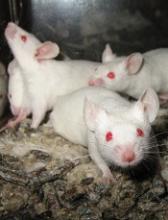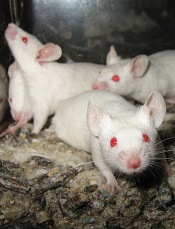User login
Preclinical research suggests PRO 140, a humanized anti-CCR5 monoclonal antibody, can prevent graft-versus-host disease (GVHD) in mice.
Mice that received 2 mg of PRO 140 twice weekly showed no signs of GVHD throughout the study period.
On the other hand, all control mice exhibited signs of GVHD, starting 25 days after engraftment, and had to be sacrificed early.
Researchers reported these results in Biology of Blood and Marrow Transplantation.
The study’s lead author, Denis R. Burger, PhD, is chief science officer of CytoDyn, the company developing PRO 140.
PRO 140 targets the CCR5 receptor, a molecule that modulates the immune cell trafficking crucial for the development of acute GVHD.
Previous clinical studies have shown that inhibiting CCR5 can reduce the clinical impact of acute GVHD without significantly affecting the engraftment of transplanted hematopoietic stem cells (HSCs).
This new study supports the idea that the CCR5 receptor on engrafted cells is critical for the development of acute GVHD and that preventing this receptor from recognizing certain immune signaling molecules is a viable approach to mitigating acute GVHD.
Dr Burger and his colleagues tested PRO 140 in NOD-scid IL-2Rynull mice transplanted with human HSCs.
Mice received 2 different doses of PRO 140 or a control antibody—2 mg or 0.2 mg—twice weekly and were followed for a maximum of 75 days.
Engraftment at the higher dose
Mice that received the 2 mg dose of PRO 140 or the control antibody had received HSCs from a 56-year-old donor.
Engraftment was similar between control and PRO 140-treated mice for the first 30+ days. However, at day 50, there were significantly fewer human CD45+ cells in the PRO 140-treated mice (P=0.034).
At 54 days, control mice had greater engraftment of mature T cells than treated mice in the peripheral blood (63.2% vs 49.8%) and bone marrow (40.2% vs 26.4%).
GVHD at the higher dose
Throughout the study period, there were no physical signs of GVHD in the PRO 140-treated mice.
However, control mice exhibited signs of GVHD starting at day 25 after bone marrow engraftment. Signs included ruffled fur, lethargy, hunching, and weight loss.
There was a significant difference in survival between the 2 groups (P<0.01). All of the control mice had to be sacrificed early, by day 56, whereas all of the PRO 140-treated animals were alive until planned sacrifice at day 75.
Engraftment at the low dose
Mice that received the 0.2 mg dose of PRO 140 or the control antibody had received HSCs from a 26-year-old donor.
Mice in the treatment and control groups achieved the same percentage of CD45+ engraftment. However, PRO 140-treated mice achieved engraftment about 20 days later than control mice (P<0.01).
GVHD at the low dose
Both control and PRO 140-treated mice showed signs of GVHD. However, weight loss was significantly greater among control mice (P<0.05).
Survival was significantly worse among control mice as well (P<0.05). All control mice were dead by 31 days, and all PRO 140-treated mice were dead by 54 days.
The researchers said the difference in survival times between these mice and the mice treated with the higher dose of antibody suggest the younger HSC donor produced more aggressive GVHD.
“This research provided CytoDyn with strong rationale for exploring the use of PRO 140 in . . . the prevention of GVHD,” Dr Burger said.
“The potential of PRO 140 to prevent this life-threatening condition could help extend the use of [HSC] transplantation, an important and effective therapy, to more patients.”
CytoDyn is currently enrolling patients in a phase 2 trial of PRO 140 in leukemia patients undergoing transplant. ![]()
Preclinical research suggests PRO 140, a humanized anti-CCR5 monoclonal antibody, can prevent graft-versus-host disease (GVHD) in mice.
Mice that received 2 mg of PRO 140 twice weekly showed no signs of GVHD throughout the study period.
On the other hand, all control mice exhibited signs of GVHD, starting 25 days after engraftment, and had to be sacrificed early.
Researchers reported these results in Biology of Blood and Marrow Transplantation.
The study’s lead author, Denis R. Burger, PhD, is chief science officer of CytoDyn, the company developing PRO 140.
PRO 140 targets the CCR5 receptor, a molecule that modulates the immune cell trafficking crucial for the development of acute GVHD.
Previous clinical studies have shown that inhibiting CCR5 can reduce the clinical impact of acute GVHD without significantly affecting the engraftment of transplanted hematopoietic stem cells (HSCs).
This new study supports the idea that the CCR5 receptor on engrafted cells is critical for the development of acute GVHD and that preventing this receptor from recognizing certain immune signaling molecules is a viable approach to mitigating acute GVHD.
Dr Burger and his colleagues tested PRO 140 in NOD-scid IL-2Rynull mice transplanted with human HSCs.
Mice received 2 different doses of PRO 140 or a control antibody—2 mg or 0.2 mg—twice weekly and were followed for a maximum of 75 days.
Engraftment at the higher dose
Mice that received the 2 mg dose of PRO 140 or the control antibody had received HSCs from a 56-year-old donor.
Engraftment was similar between control and PRO 140-treated mice for the first 30+ days. However, at day 50, there were significantly fewer human CD45+ cells in the PRO 140-treated mice (P=0.034).
At 54 days, control mice had greater engraftment of mature T cells than treated mice in the peripheral blood (63.2% vs 49.8%) and bone marrow (40.2% vs 26.4%).
GVHD at the higher dose
Throughout the study period, there were no physical signs of GVHD in the PRO 140-treated mice.
However, control mice exhibited signs of GVHD starting at day 25 after bone marrow engraftment. Signs included ruffled fur, lethargy, hunching, and weight loss.
There was a significant difference in survival between the 2 groups (P<0.01). All of the control mice had to be sacrificed early, by day 56, whereas all of the PRO 140-treated animals were alive until planned sacrifice at day 75.
Engraftment at the low dose
Mice that received the 0.2 mg dose of PRO 140 or the control antibody had received HSCs from a 26-year-old donor.
Mice in the treatment and control groups achieved the same percentage of CD45+ engraftment. However, PRO 140-treated mice achieved engraftment about 20 days later than control mice (P<0.01).
GVHD at the low dose
Both control and PRO 140-treated mice showed signs of GVHD. However, weight loss was significantly greater among control mice (P<0.05).
Survival was significantly worse among control mice as well (P<0.05). All control mice were dead by 31 days, and all PRO 140-treated mice were dead by 54 days.
The researchers said the difference in survival times between these mice and the mice treated with the higher dose of antibody suggest the younger HSC donor produced more aggressive GVHD.
“This research provided CytoDyn with strong rationale for exploring the use of PRO 140 in . . . the prevention of GVHD,” Dr Burger said.
“The potential of PRO 140 to prevent this life-threatening condition could help extend the use of [HSC] transplantation, an important and effective therapy, to more patients.”
CytoDyn is currently enrolling patients in a phase 2 trial of PRO 140 in leukemia patients undergoing transplant. ![]()
Preclinical research suggests PRO 140, a humanized anti-CCR5 monoclonal antibody, can prevent graft-versus-host disease (GVHD) in mice.
Mice that received 2 mg of PRO 140 twice weekly showed no signs of GVHD throughout the study period.
On the other hand, all control mice exhibited signs of GVHD, starting 25 days after engraftment, and had to be sacrificed early.
Researchers reported these results in Biology of Blood and Marrow Transplantation.
The study’s lead author, Denis R. Burger, PhD, is chief science officer of CytoDyn, the company developing PRO 140.
PRO 140 targets the CCR5 receptor, a molecule that modulates the immune cell trafficking crucial for the development of acute GVHD.
Previous clinical studies have shown that inhibiting CCR5 can reduce the clinical impact of acute GVHD without significantly affecting the engraftment of transplanted hematopoietic stem cells (HSCs).
This new study supports the idea that the CCR5 receptor on engrafted cells is critical for the development of acute GVHD and that preventing this receptor from recognizing certain immune signaling molecules is a viable approach to mitigating acute GVHD.
Dr Burger and his colleagues tested PRO 140 in NOD-scid IL-2Rynull mice transplanted with human HSCs.
Mice received 2 different doses of PRO 140 or a control antibody—2 mg or 0.2 mg—twice weekly and were followed for a maximum of 75 days.
Engraftment at the higher dose
Mice that received the 2 mg dose of PRO 140 or the control antibody had received HSCs from a 56-year-old donor.
Engraftment was similar between control and PRO 140-treated mice for the first 30+ days. However, at day 50, there were significantly fewer human CD45+ cells in the PRO 140-treated mice (P=0.034).
At 54 days, control mice had greater engraftment of mature T cells than treated mice in the peripheral blood (63.2% vs 49.8%) and bone marrow (40.2% vs 26.4%).
GVHD at the higher dose
Throughout the study period, there were no physical signs of GVHD in the PRO 140-treated mice.
However, control mice exhibited signs of GVHD starting at day 25 after bone marrow engraftment. Signs included ruffled fur, lethargy, hunching, and weight loss.
There was a significant difference in survival between the 2 groups (P<0.01). All of the control mice had to be sacrificed early, by day 56, whereas all of the PRO 140-treated animals were alive until planned sacrifice at day 75.
Engraftment at the low dose
Mice that received the 0.2 mg dose of PRO 140 or the control antibody had received HSCs from a 26-year-old donor.
Mice in the treatment and control groups achieved the same percentage of CD45+ engraftment. However, PRO 140-treated mice achieved engraftment about 20 days later than control mice (P<0.01).
GVHD at the low dose
Both control and PRO 140-treated mice showed signs of GVHD. However, weight loss was significantly greater among control mice (P<0.05).
Survival was significantly worse among control mice as well (P<0.05). All control mice were dead by 31 days, and all PRO 140-treated mice were dead by 54 days.
The researchers said the difference in survival times between these mice and the mice treated with the higher dose of antibody suggest the younger HSC donor produced more aggressive GVHD.
“This research provided CytoDyn with strong rationale for exploring the use of PRO 140 in . . . the prevention of GVHD,” Dr Burger said.
“The potential of PRO 140 to prevent this life-threatening condition could help extend the use of [HSC] transplantation, an important and effective therapy, to more patients.”
CytoDyn is currently enrolling patients in a phase 2 trial of PRO 140 in leukemia patients undergoing transplant. ![]()

